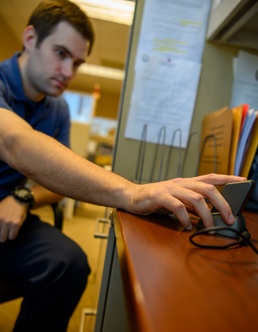
MILLINGTON, Tenn. (NNS) - The use of biometrics is becoming commonplace granting people immediate access to their phones, computers, buildings and cars. This technology makes accessing personal information easier and secure using an identifier unique to each individual. As of Oct. 1, the Navy began using this technology to make the enlistment process more efficient and less wasteful.
Navy recruiters are no longer required to print out the majority of forms necessary to process a future Sailor. The traditional way to create a member’s official military personnel file (OMPF) required applicants to “wet sign” all of their forms – i.e., using a pen to sign in ink on a hard copy. Through the use of biometric signing, which takes an applicant’s fingerprint as a replacement for a signature, recruiters are able to work straight off the electronic version of forms, removing the extra step of creating a physical copy.
“The key thing is, if you wet sign something, it’s got to be scanned and uploaded. Before you scan it, you have to print it,” said Gary Morse, assistant project coordinator for the Personalized Recruiting for Immediate and Delayed Enlistments (PRIDE) application where the biometrics project has been managed under the project leadership of Jeff Keating. “If our goal is to add 40,000-45,000 Sailors to our system and it takes us processing nearly 60,000 people to do that, it’s a lot of paper, a lot of ink and a lot of wear and tear on printers. So we can cut that down to where we’re no longer doing all of that printing and scanning, and we save the time that it takes.”
Prior to using biometric signing, the Navy enlistment kit consisted of approximately 150 sheets of paper per person. This kit was then made in to four copies which resulted in about 600 pieces of paper per prospective Sailor. If you multiply that figure by the approximately 60,000 people that are processed annually, it results in 36 million sheets of paper per year. At the average cost of 7 cents per sheet of paper used, the cost per year, in paper alone, of processing personnel into the Navy was around $2.5 million. As the cost of enacting the program was about $180,000, this project has created significant cost avoidance for the Navy while having a positive impact environmentally.
“I honestly do not believe that is the most powerful piece,” said Dr. Kevin Sullivan, the deputy commander and executive director of Commander, Navy Recruiting Command. “What is more powerful is the efficiency we got overall. For the first time we have parallel processing.”
With parallel processing, all of the documents that are created during the acquisition process are stored digitally in an encrypted database. This database allows Navy Recruiting Command (NRC), Navy Personnel Command, and Recruit Training Command access to the original records while also enabling them to perform further processing of individuals. This process also creates a reduction in the possibility of personally identifiable information (PII) falling into the wrong hands as recruits are no longer required to carry a copy of their enlistment kit to boot camp. Now recruits report to boot camp with three pieces of paper; their orders, their meal pass, and their medical form.
As of Nov. 1, NRC successfully processed more than 700,000 forms using the new biometric method. Biometric signing is different from the biometrics used for identity verification. Devices that use biometrics store a copy of the finger print in the device and actively compare it when a user is trying to access the device. However, the Navy’s technology is simply allowing users to use their biometrics in place of a signature. In the case of fraudulent activity, the Navy is able to compare the fingerprint of the signer against what was put on the document.
“A member signs these forms using two separate fingers on the documents,” said Matt Gomez, director of N6 Requirements and Project management office, Commander, Navy Recruiting Command. “We have one that we show on the actual document … so you see an actual fingerprint and we save the other one in the background, inside of the form.”
Through biometrics, the document now has something that is an actual, legal signature that is then embedded into the document. The October rollout of the project was the culmination of years of work trying to implement the technology.
“It’s one thing to capture a fingerprint. It’s another to do something with it,” said Morse. “First, we had to get approval at the DOD (Department of Defense) and DON (Department of the Navy) level to actually be able to substitute a biometric fingerprint for a [wet] signature.”
Jeff Keating and his team’s work was critical in obtaining this approval. After establishing the legality of a biometric signature, the technology to sign documents biometrically had to be developed. To solve this problem, the project team worked with Adobe software engineers and designed a custom plug-in that allowed documents to be signed biometrically. This required some forms to be redesigned to accommodate the new features.
The use of biometrics is one more step forward toward becoming a paperless Navy, and although the Navy piloted this technology, it is now available for use by all DOD assets.
Navy Recruiting Command consists of a command headquarters, three Navy Recruiting Regions, 16 Navy Recruiting Districts and 10 Navy Talent Acquisition Groups that serve more than 1,330 recruiting stations across the world. Their combined goal is to attract the highest quality candidates to assure the ongoing success of America’s Navy.
For more news from Commander, Navy Recruiting Command, go to http://www.cnrc.navy.mil. Follow Navy Recruiting on Facebook (www.facebook.com/NavyRecruiting), Twitter (@USNRecruiter) and Instagram (@USNRecruiter).